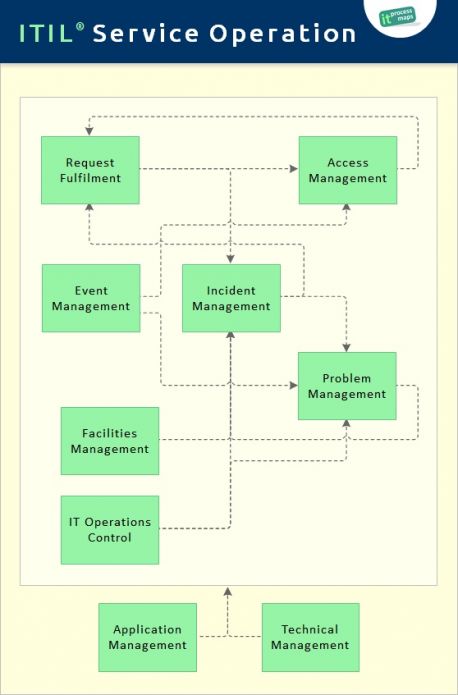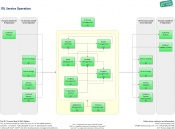ITIL Service Operation: Difference between revisions
| Line 20: | Line 20: | ||
<imagemap> | <imagemap> | ||
Image: | Image:Service-operation-itil.jpg||left|ITIL Service Operation - Click on a process for more details|458px|thumb|alt=Service Operation ITIL | ||
rect | rect 37 132 138 202 [[Request Fulfilment|Request Fulfilment - Service Operation]] | ||
rect | rect 296 136 397 203 [[Access Management|Access Management - Service Operation]] | ||
rect | rect 39 262 139 330 [[Event Management|Event Management - Service Operation]] | ||
rect | rect 178 261 278 332 [[Incident Management|Incident Management - Service Operation]] | ||
rect | rect 295 348 396 416 [[Problem Management|Problem Management - Service Operation]] | ||
rect | rect 57 399 158 471 [[IT Facilities Management|Facilities Management - Service Operation]] | ||
rect | rect 57 489 157 558 [[IT Operations Control|IT Operations Control - Service Operation]] | ||
rect 103 591 203 660 [[ITIL Application Management|Application Management - Service Operation]] | |||
rect 257 591 359 661 [[ITIL Technical Management|Technical Management - Service Operation]] | |||
desc bottom-left | desc bottom-left | ||
</imagemap> | </imagemap> | ||
As per '''ITIL 2011''', the following processes are part of the ITIL stage [[ITIL V3 Service Operation|Service Operation]]: | |||
<p> </p> | <p> </p> | ||
| Line 50: | Line 52: | ||
:Process Objective: To manage the lifecycle of all Problems. The primary objectives of Problem Management are to prevent Incidents from happening, and to minimize the impact of incidents that cannot be prevented. Proactive Problem Management analyzes Incident Records, and uses data collected by other IT Service Management processes to identify trends or significant Problems. | :Process Objective: To manage the lifecycle of all Problems. The primary objectives of Problem Management are to prevent Incidents from happening, and to minimize the impact of incidents that cannot be prevented. Proactive Problem Management analyzes Incident Records, and uses data collected by other IT Service Management processes to identify trends or significant Problems. | ||
;[[IT Operations | ;[[IT Operations Control]] | ||
:Process Objective: To monitor and control the IT services and infrastructure. The process IT Operations | :Process Objective: To monitor and control the IT services and their underlying infrastructure. The process IT Operations Control executes day-to-day routine tasks related to the operation of infrastructure components and applications. This includes job scheduling, backup and restore activities, print and output management, and routine maintenance. | ||
;[[IT Facilities Management]] | ;[[IT Facilities Management|Facilities Management]] | ||
:Process Objective: To manage the physical environment where the IT | :Process Objective: To manage the physical environment where the IT infrastructure is located. Facilities Management includes all aspects of managing the physical environment, for example power and cooling, building access management, and environmental monitoring. | ||
;[[ITIL Application Management|Application Management]] | |||
: Application Management is responsible for managing applications throughout their lifecycle. | |||
;[[ITIL Technical Management|Technical Management]] | ;[[ITIL Technical Management|Technical Management]] | ||
:Technical Management provides technical expertise and support for the management of the IT infrastructure. | :Technical Management provides technical expertise and support for the management of the IT infrastructure. | ||
<p> </p> | <p> </p> | ||
| Line 83: | Line 89: | ||
|} | |} | ||
== Demo ITIL Process Map | <p> </p> | ||
== Demo Service Operation: ITIL Process Map == | |||
The [https://en.it-processmaps.com/products/demo-itil-process-map.html ITIL Process Map V3 video] shows samples of the ITIL process templates with contents from Service Operation and Incident Management processes, including the | The [https://en.it-processmaps.com/products/demo-itil-process-map.html ITIL Process Map V3 video] shows samples of the ITIL process templates with contents from Service Operation and Incident Management processes, including the | ||
* high-level view of the ITIL | * high-level view of the ITIL Service Lifecycle (Level 0) | ||
* overview of the Service Operation process (Level 1) | * overview of the Service Operation process (Level 1) | ||
* overview of the Incident Management process (Level 2) | * overview of the Incident Management process (Level 2) | ||
* detailed process flow for the process "Incident Resolution by 1st Level Support" (Level 3) | * detailed process flow for the process "Incident Resolution by 1st Level Support" (Level 3) | ||
<p> </p> | |||
<!-- This page is assigned to the following categories: --> | <!-- This page is assigned to the following categories: --> | ||
[[Category:ITIL V3]][[Category:ITIL | [[Category:ITIL V3]][[Category:ITIL 2011]][[Category:ITIL stage]][[Category:ITIL process|4]][[Category:Service Operation|!]] | ||
<!-- --- --> | <!-- --- --> | ||
Revision as of 19:20, 21 December 2011
<seo metakeywords="service operation, itil service operation, itil service operations, service operations, itil v3 service operation, service operation processes" metadescription="ITIL Service Operation: Definition - Processes - Additional information on Service Operation: ITIL Roles, Checklists, KPIs..." />

ITIL Service Operation
The objective of ITIL Service Operation is to make sure that IT services are delivered effectively and efficiently. This includes fulfilling user requests, resolving service failures, fixing problems, as well as carrying out routine operational tasks.
Part of: IT Service Management
Processes: ITIL Service Operation

As per ITIL 2011, the following processes are part of the ITIL stage Service Operation:
- Event Management
- Process Objective: To make sure CIs and services are constantly monitored, and to filter and categorize Events in order to decide on appropriate actions.
- Incident Management
- Process Objective: To manage the lifecycle of all Incidents. The primary objective of Incident Management is to return the IT service to users as quickly as possible.
- Request Fulfilment
- Process Objective: To fulfill Service Requests, which in most cases are minor (standard) Changes (e.g. requests to change a password) or requests for information.
- Access Management
- Process Objective: To grant authorized users the right to use a service, while preventing access to non-authorized users. The Access Management processes essentially execute policies defined in Information Security Management. Access Management is sometimes also referred to as Rights Management or Identity Management.
- Problem Management
- Process Objective: To manage the lifecycle of all Problems. The primary objectives of Problem Management are to prevent Incidents from happening, and to minimize the impact of incidents that cannot be prevented. Proactive Problem Management analyzes Incident Records, and uses data collected by other IT Service Management processes to identify trends or significant Problems.
- IT Operations Control
- Process Objective: To monitor and control the IT services and their underlying infrastructure. The process IT Operations Control executes day-to-day routine tasks related to the operation of infrastructure components and applications. This includes job scheduling, backup and restore activities, print and output management, and routine maintenance.
- Facilities Management
- Process Objective: To manage the physical environment where the IT infrastructure is located. Facilities Management includes all aspects of managing the physical environment, for example power and cooling, building access management, and environmental monitoring.
- Application Management
- Application Management is responsible for managing applications throughout their lifecycle.
- Technical Management
- Technical Management provides technical expertise and support for the management of the IT infrastructure.
Additional Information on Service Operation
Downloads
Overview Service Operation
|
Use the following links to open the process overview of Service Operation showing the most important interfaces: |
 |
Demo Service Operation: ITIL Process Map
The ITIL Process Map V3 video shows samples of the ITIL process templates with contents from Service Operation and Incident Management processes, including the
- high-level view of the ITIL Service Lifecycle (Level 0)
- overview of the Service Operation process (Level 1)
- overview of the Incident Management process (Level 2)
- detailed process flow for the process "Incident Resolution by 1st Level Support" (Level 3)






